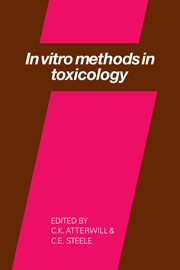Book contents
- Frontmatter
- Contents
- List of contributors
- Preface
- Introduction
- TARGET ORGAN TOXICITY
- GENERAL AND TOPICAL TOXICITY
- REPRODUCTIVE TOXICITY
- An in vitro test for teratogens using cultures of rat embryo cells
- Postimplantation embryo culture and its application to problems in teratology
- Sub-mammalian and sub-vertebrate models in teratogenicity screening
- The use of in vitro techniques to investigate the action of testicular toxicants
- An in vitro assessment of ovarian function: a potential tool for investigating mechanisms of toxicity in the ovary
- CONCLUSION
- Index
An in vitro assessment of ovarian function: a potential tool for investigating mechanisms of toxicity in the ovary
Published online by Cambridge University Press: 06 August 2010
- Frontmatter
- Contents
- List of contributors
- Preface
- Introduction
- TARGET ORGAN TOXICITY
- GENERAL AND TOPICAL TOXICITY
- REPRODUCTIVE TOXICITY
- An in vitro test for teratogens using cultures of rat embryo cells
- Postimplantation embryo culture and its application to problems in teratology
- Sub-mammalian and sub-vertebrate models in teratogenicity screening
- The use of in vitro techniques to investigate the action of testicular toxicants
- An in vitro assessment of ovarian function: a potential tool for investigating mechanisms of toxicity in the ovary
- CONCLUSION
- Index
Summary
INTRODUCTION
The survival of a species depends on the Integrity of Its reproductive system, thus the toxic effects of drugs and environmental chemicals on the human reproductive system is an important health concern. The potential toxicity of such chemicals to the human in utero, one of the most vulnerable stages of development, is the focus for most studies 1n reproductive toxicology and includes assessment of the higher (hypothalamus - pituitary) control of reproductive function, for example blood hormone measurement. However, the incidences of chemically Induced germ cell damage and sterility appear to be on the increase, with many chemicals shown to have a direct toxic effect on the female gonads (Harbison and Dixon, 1978).
In female mammals, all germ cells are formed in the ovary before birth. Many of these become atretic so that by puberty only half the initial number of oocytes remain. Therefore, any agent that damages the oocyte will accelerate the depletion of oocyte number, thereby reducing fertility. After birth, the development of all germ cells progresses no further than the primary oocyte stage (diplotene) until just before they ovulate. Thus, in the adult, follicles in various stages of growth can always be found, although only a few achieve maturity and ovulate.
The follicle consists of an inner granulosa cell layer, which extends to surround the oocyte (the cumulus oophorous) and an outer layer, the theca folliculi made up of the theca interna and theca externa (Figure 1).
Information
- Type
- Chapter
- Information
- In Vitro Methods in Toxicology , pp. 425 - 440Publisher: Cambridge University PressPrint publication year: 1987
